Discover 11 hidden attractions, cool sights, and unusual things to do in Kluane National Park (Canada). Don't miss out on these must-see attractions: Mount Saint Elias, Mount Logan, and Kaskawulsh Mountain. Also, be sure to include Mount Lucania in your itinerary.
Below, you can find the list of the most amazing places you should visit in Kluane National Park (Yukon).
Table of Contents
Mount Saint Elias

Mount in North America. Mount Saint Elias, the second-highest mountain in both Canada and the United States, stands on the Yukon and Alaska border about 26 miles southwest of Mount Logan, the highest mountain in Canada. The Canadian side of Mount Saint Elias forms part of Kluane National Park and Reserve, while the U.S. side of the mountain is located within Wrangell-St. Elias National Park and Preserve.
Its name in Tlingit, Yasʼéitʼaa Shaa, means "mountain behind Icy Bay"; the Yakutat Tlingit occasionally call it Shaa Tlein "Big Mountain". It is one of the most important crests of the Kwaashkʼiḵwáan clan, who used it as a guide during their journey down the Copper River. Mount Fairweather at the apex of the British Columbia and Alaska borders at the head of the Alaska Panhandle is known as Tsalx̱aan; legend states that this mountain and Yasʼéitʼaa Shaa (Mt. St. Elias) originally stood next to each other, but had an argument and separated. Their children, the mountains in between the two peaks, are called Tsalx̱aan Yátxʼi ("Children of Tsalxaan").
European explorers first sighted the mountain on July 16, 1741, with the arrival of the expedition commanded by Vitus Bering, a Danish explorer in service of Russia. While some historians contend that Bering named the mountain, others believe that eighteenth-century mapmakers named it after Cape Saint Elias when Bering left the peak unnamed.
Mount Saint Elias is notable for its immense vertical relief. Its summit rises 18,008 feet (5,489 m) vertically in just 10 miles (16 km) horizontal distance from the head of Taan Fjord, off of Icy Bay.
In 2007 Gerald Salmina directed an Austrian documentary film, Mount St. Elias, about a team of skier/mountaineers determined to make "the planet's longest skiing descent" by ascending the mountain and then skiing nearly all 18,000 feet down to the Gulf of Alaska; the movie finished editing and underwent limited release in 2009. The climbers ended up summiting on the second attempt and skiing down to 13,000 ft (3,960 m).[1]
Mount Logan
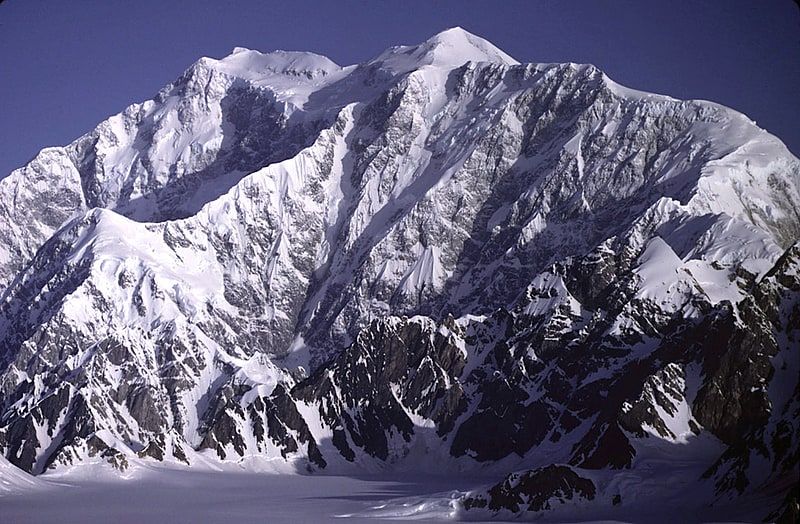
Mountain in Canada. Mount Logan is the highest mountain in Canada and the second-highest peak in North America after Denali. The mountain was named after Sir William Edmond Logan, a Canadian geologist and founder of the Geological Survey of Canada. Mount Logan is located within Kluane National Park Reserve in southwestern Yukon, less than 40 kilometres north of the Yukon–Alaska border. Mount Logan is the source of the Hubbard and Logan glaciers. Logan is believed to have the largest base circumference of any non-volcanic mountain on Earth, including a massif with eleven peaks over 5,000 metres.
Due to active tectonic uplifting, Mount Logan is still rising in height (approximately 0.35 mm per year). Before 1992, the exact elevation of Mount Logan was unknown and measurements ranged from 5,959 to 6,050 metres (19,551 to 19,849 ft). In May 1992, a GSC expedition climbed Mount Logan and fixed the current height of 5,959 metres (19,551 ft) using GPS.
Temperatures are extremely low on and near Mount Logan. On the 5,000-metre-high (16,000 ft) plateau, air temperature hovers around −45 °C (−49 °F) in the winter and reaches near freezing in summer with the median temperature for the year around −27 °C (−17 °F). Minimal snow melt leads to a significant ice cap, reaching almost 300 metres (980 ft) in certain spots.[2]
Kaskawulsh Mountain
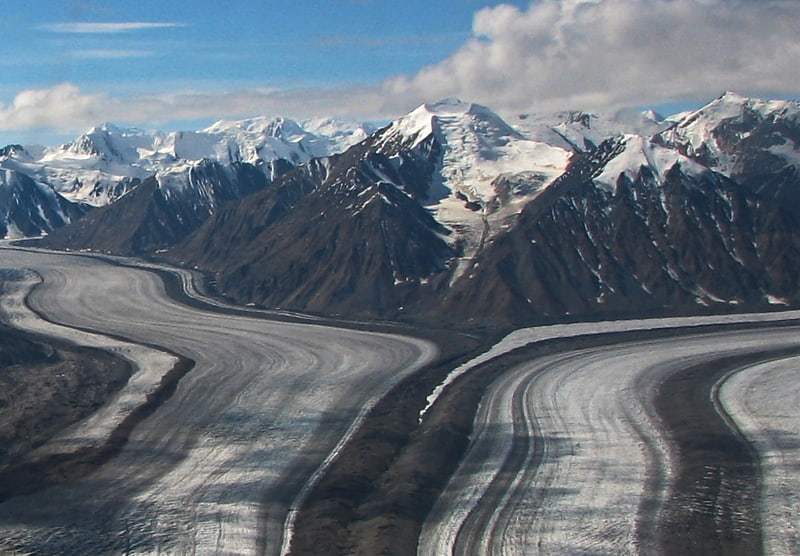
Mountain in Canada. Kaskawulsh Mountain is a 2,969-metre mountain summit of the Saint Elias Mountains in Kluane National Park of Yukon, Canada. Surrounded by ice on all sides, the mountain is situated in the notch where the main arm of the Kaskawulsh Glacier merges with its south arm. The Stairway Glacier lies to the west, and the Atrypa Glacier to the south. The mountain cannot be seen from any roads, but can be seen by plane, or by hiking to the summit of Observation Mountain which is located at the head of the Slims River valley. The nearest higher peak is GJ43, 3.8 km to the west.[3]
Mount Lucania
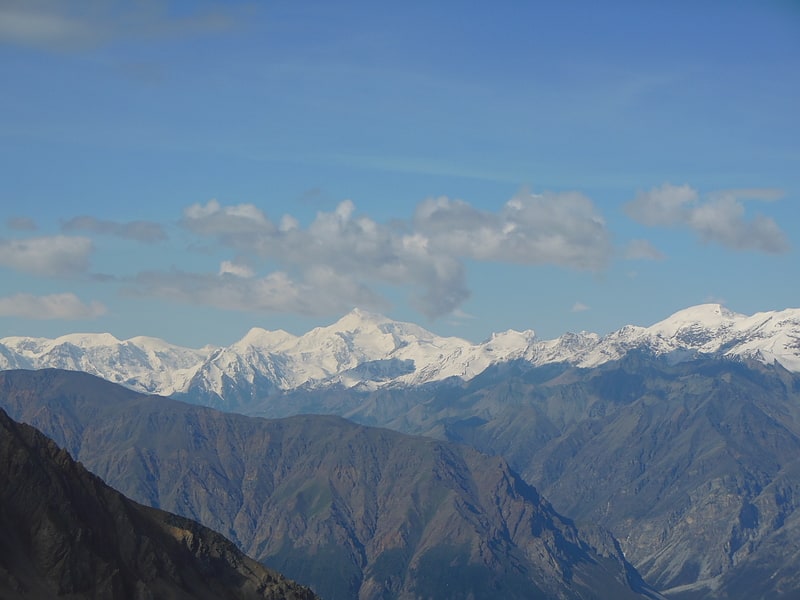
Mountain in Canada. Mount Lucania is the third-highest mountain in Canada, and the second-highest mountain located entirely within the country. A long ridge connects Mount Lucania with Mount Steele, the fifth-highest in Canada. Lucania was named by the Duke of Abruzzi, as he stood on the summit of Mount Saint Elias on July 31, 1897, having just completed the first ascent. Seeing Lucania in the far distance, beyond Mount Logan, he immediately named it "after the ship on which the expedition had sailed from Liverpool to New York," the RMS Lucania.
The first ascent of Mount Lucania was made in 1937 by Bradford Washburn and Robert Hicks Bates. They used an airplane to reach Walsh Glacier, 2,670 m (8,760 ft) above sea level; the use of air support for mountaineering was novel at the time. Washburn called upon Bob Reeve, a famous Alaskan bush pilot, who later replied by cable to Washburn, "Anywhere you'll ride, I'll fly". The ski-equipped Fairchild F-51 made several trips to the landing site on the glacier without event in May, but on landing with Washburn and Bates in June, the plane sank into unseasonal slush. Washburn, Bates and Reeve pressed hard for five days to get the airplane out and Reeve was eventually able to get the airplane airborne with all excess weight removed and with the assistance of a smooth icefall with a steep drop. Washburn and Bates continued on foot to make the first ascent of Lucania, and in an epic descent and journey to civilization, they hiked over 150 miles (240 km) through the wilderness to safety in the small town of Burwash Landing in the Yukon.
The second ascent of Lucania was made in 1967 by Jerry Halpern, Mike Humphreys, Gary Lukis, and Gerry Roach.
In April-May 2021, Pascale Marceau and Eva Capozzola summited the peak, the first all-woman team of climbers to do so.[4]
Mount Kennedy
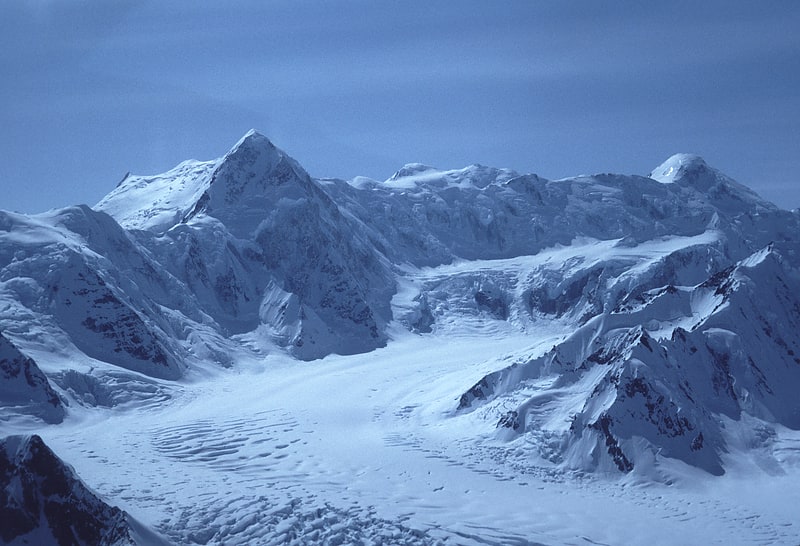
Peak in Canada. Mount Kennedy is a peak in the Saint Elias Mountains within Kluane National Park, in Yukon, Canada. Its 4250-m to 4300-m summit lies within 10 km of the Alaska Panhandle. Dusty Glacier lies against it to the north.
The Canadian government named the peak in honour of U.S. President John F. Kennedy nearly a year following his assassination. In announcing the decision to the House of Commons on November 20, 1964, prime minister Lester B. Pearson said "I believe it is appropriate that Canada's memorial to him should be a mountain. A mountain is solid and enduring. Mount Kennedy is a graceful, towering, unencumbered peak.. a symbol of aspiration and upward reach." It was at the time, the highest peak in North America that had not yet been climbed. American mountaineer Bradford Washburn who had aided the Canadian government in selecting the peak said that "the Canadians sought a mountain that had not previously been named, that towered lofty and magnificent, and that lay as close as possible to the international boundary, where it would endure as a symbol of the unique friendship that exists between our two great nations."[5]
Mount Steele
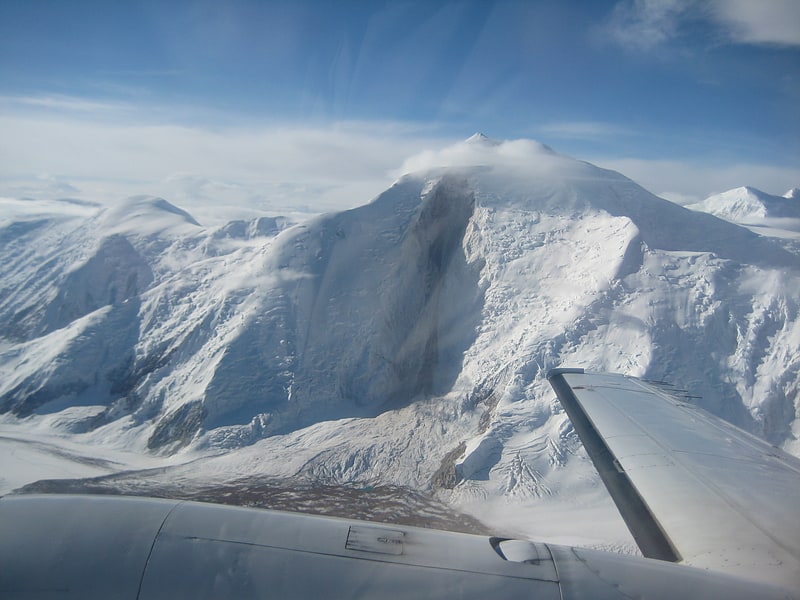
Mountain in Canada. Mount Steele is the fifth-highest mountain in Canada and either the tenth- or eleventh-highest peak in North America. Its exact elevation is uncertain. Commonly-quoted figures are 5,073 metres and 5,020 metres. A lower southeast peak of Mt. Steele stands at 4,300 m.
It was named after Sir Sam Steele, the North-West Mounted Police officer in charge of the force in the Yukon during the Klondike Gold Rush.[6]
Kathleen Lake
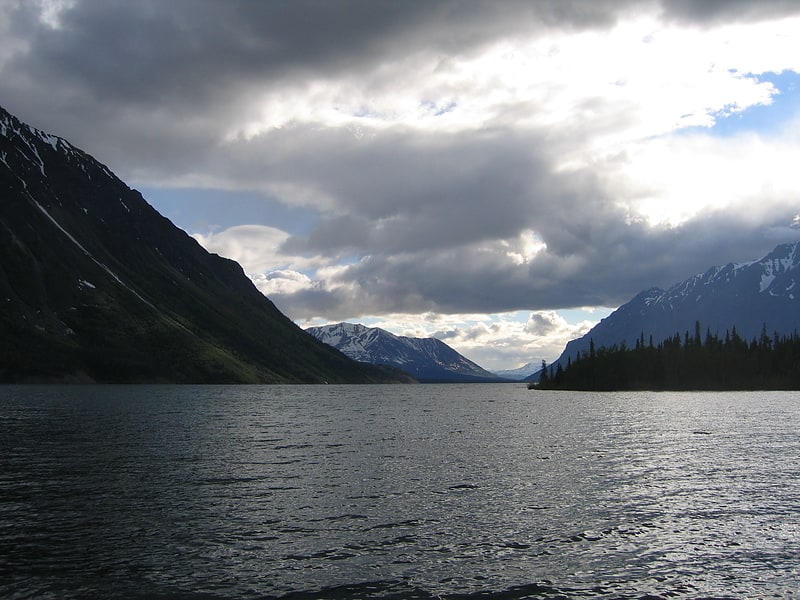
Lake in Canada. Kathleen Lake is a lake in Yukon, Canada, located south of the town of Haines Junction within Kluane National Park and Reserve. Located at Haines Highway Kilometre 219.7. It hosts a day-use area, a boat launch, a campground, and several hiking trails, including the challenging 3.1 mi ascent to King's Throne, a natural, glacially-formed amphitheater overlooking the lake.
Kathleen Lake is characterized by exceptionally clear waters and the presence of kokanee salmon, a landlocked population of Sockeye living and reproducing solely in freshwater bodies.
Kathleen Lake was named for a girl from Berwickshire County, Scotland, left behind by William "Scotty" Hume (1868–1950), a North-West Mounted Police constable (Reg. #2259) stationed on the Dalton Trail from 1900 to 1902.[7]
Kluane / Wrangell–St. Elias / Glacier Bay / Tatshenshini-Alsek

Park. Kluane / Wrangell–St. Elias / Glacier Bay / Tatshenshini-Alsek is an international park system located in Canada and the United States, at the border of Yukon, Alaska and British Columbia.
It was declared a UNESCO World Heritage Site in 1994 for the spectacular glacier and icefield landscapes as well as for the importance of grizzly bears, caribou and Dall sheep habitat. The total area of the site is 98391.21 square kilometres (37989.06 sq mi).
It is home to the world's largest non-polar icefield.[8]
King Peak
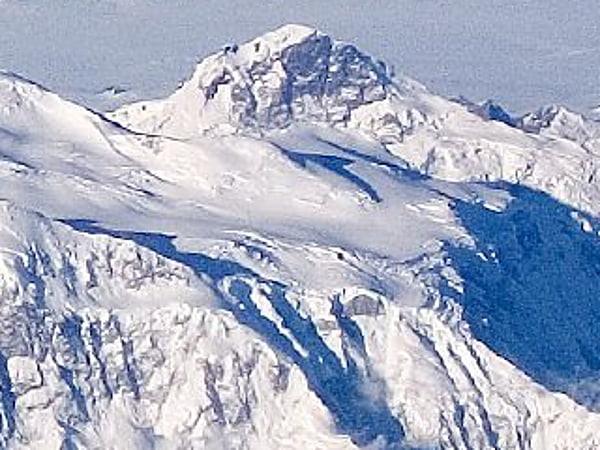
Mountain in Canada. King Peak is the fourth-highest mountain in Canada and the ninth-highest peak in North America. Situated just west of Mount Logan, in Yukon, it is considered a satellite peak of that massive mountain.[9]
Mount Alverstone
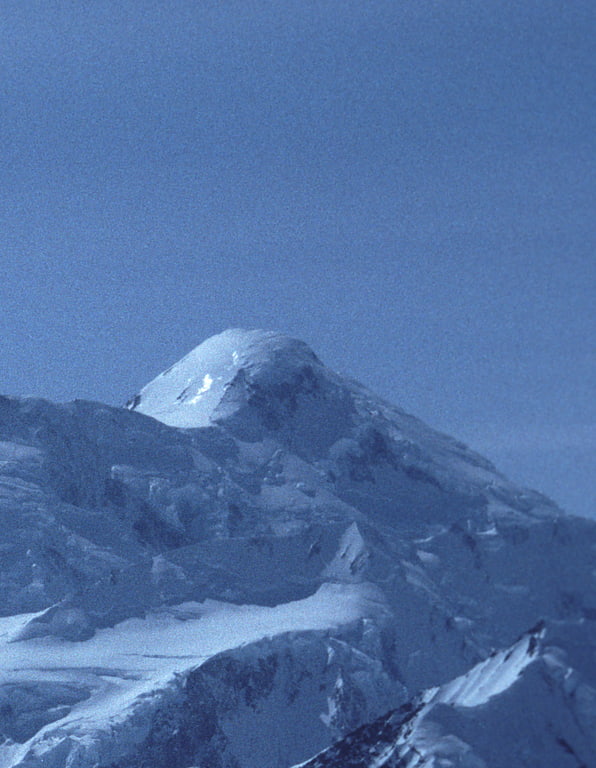
Peak in North America. Mount Alverstone or Boundary Peak 180, is a high peak in the Saint Elias Mountains, on the border between Alaska and Yukon. It shares a large massif with the higher Mount Hubbard to the south and the slightly lower Mount Kennedy to the east. The summit of Mount Alverstone marks a sharp turn in the Alaska/Canada border; the border goes south from this point toward the Alaska panhandle and west toward Mount Saint Elias.
The mountain was named in 1908 for Lord Richard Everard Webster Alverstone, Lord Chief Justice of England, 1900–13, and U.S. Boundary Commissioner in 1903. He served on various arbitration commissions including the one dealing with the Bering Sea Fur seal controversy. In the Alaska boundary dispute in 1903, his vote was the deciding one against Canadian claims.[10]
Kaskawulsh Glacier
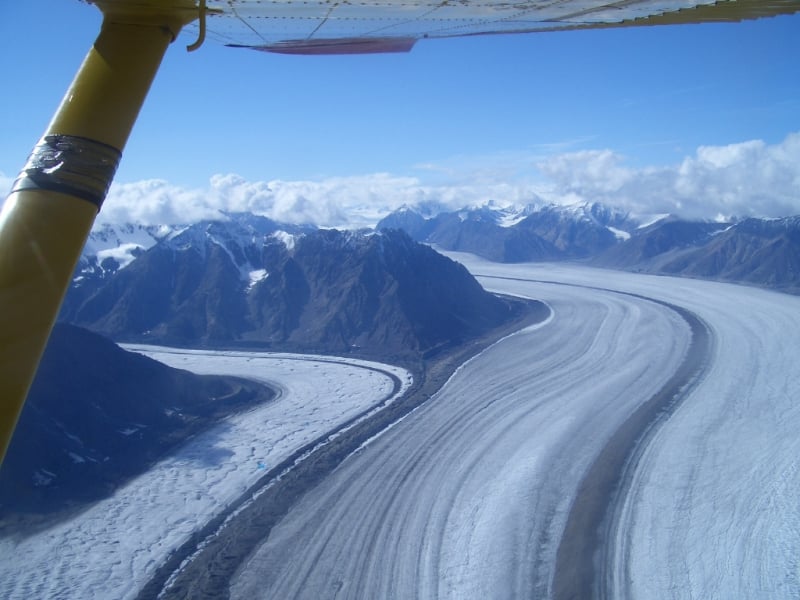
Glacier in Canada. The Kaskawulsh Glacier is a vast, temperate valley glacier nestled in the St. Elias Mountains, within Kluane National Park in the Canadian territory of Yukon.[11]